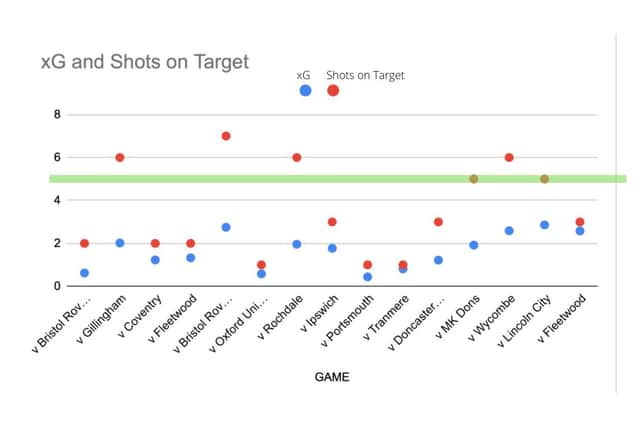The concerning data that highlights Sunderland's major failing and how it could derail their promotion push


Jonson Clarke-Harris’ brace sentenced the Black Cats to defeat and means they have now gone four games without a win in League One, in what represents a significant dent in their promotion ambitions.
But what will the Sunderland boss have learned from the reverse in the South West?
Advertisement
Hide AdAdvertisement
Hide AdWe take a look at the key lessons for Parkinson and his side to take:


SUNDERLAND SIMPLY AREN’T CREATING ENOUGH
At this time last season, Sunderland’s lack of a creative presence was rued.
Fast forward twelve months and there’s a real sense of deja vu. For all Phil Parkinson did some good business in the January window, he failed to add a real creative spark to the side.
Lynden Gooch and Chris Maguire have bared the brunt of the responsibility when it comes to forging opportunities for the Black Cats but, in recent weeks, the side have really struggled to carve open teams in the final third.
Advertisement
Hide AdAdvertisement
Hide AdPart of that may be down to smart work on their opponents’ part - which we’ll come onto later - but Sunderland themselves need to do more.
That was abundantly clear at Bristol Rovers where, for all Parkinson’s side saw plenty of the ball, they mustered only two shots on targets. Neither of these efforts were of any trouble for stopper Jamal Blackman either.
Indeed, it’s interesting to cast a glance at Sunderland’s recent data when it comes to creating chances.
In IMAGE ONE, you can see the Black Cats’ xG (expected goals) and shots on target for every game since the turn of the year.
Advertisement
Hide AdAdvertisement
Hide AdWhile some games show an impressive number of chances created, the majority do not.
In only four of the 15 games have Sunderland managed to produce more than five shots on target.
In four of their last six games, the Black Cats have mustered no more than two shots on targets.
But this isn’t a recent problem. Look back at the clashes with Tranmere, Portsmouth and even Doncaster Rovers. Sunderland have struggled to create chances and have managed to grind out points via set-pieces or stern defending. During Sunderland’s impressive run of clean sheets, the side’s inability to create chances was obscured by the ability to keep the opposition out - meaning a point as a minimum was guaranteed.
Advertisement
Hide AdAdvertisement
Hide AdThis was only ever going to be a short-term measure though. Promotion-winning teams cannot rely on a strong defence alone and, as Sunderland start to leak goals again, their failure to address a clear deficiency in the attacking areas is coming to the fore.
Parkinson will have to address this quickly. Sunderland need to create - and score - more if they are to have any hopes of getting out of League One this term.
TEAMS ARE STARTING TO FIGURE OUT SUNDERLAND
While Sunderland’s 3-4-3 formation bore fruit when first introduced at the turn of the year, it is now becoming slightly predictable.
Teams are starting to figure out how to combat the shape and, crucially, stop the Black Cats from getting the space they crave in attacking areas.
Advertisement
Hide AdAdvertisement
Hide AdWhen Parkinson’s side enjoyed a spell of possession in the first half at Bristol Rovers, the hosts defended deep; thus restricting the space behind and forcing Sunderland to play through them - which they failed to do.
We’ve seen similar tactics employed by Doncaster, Fleetwood and Tranmere among others in recent weeks, all of whom managed to frustrate Sunderland for long spells.
So there now seems to be a ‘blueprint’ of how to defend against the Black Cats, and the onus is on Parkinson to find ways of combating sides who simply want to sit deep, defend, and play on the counter.
Sunderland’s better performances – Wycombe, for example – have come against teams who look to get forward and play an open game. This in turn leaves spaces behind for the Black Cats to exploit, which they have done well.
Advertisement
Hide AdAdvertisement
Hide AdBut when teams sit back, defend and look simply to frustrate, Sunderland look bereft of ideas. They seem to lack the craft and guile to unlock defences and are forced to go long in a bid to break through.
A more effective plan B is needed.
THE THREE-WEEK BREAK CANNOT COME SOON ENOUGH
Sunderland need a rest. Physically, mentally and emotionally, this squad looks exhausted.
Until recent weeks, Parkinson had largely stuck with the same starting line-up and so it is perhaps no surprise to see that some players require a rest - especially given the robust nature of League One and it’s scheduling.
The upcoming three-week break - assuming the game at Southend is called-off, of course - could be coming at a perfect time.
Advertisement
Hide AdAdvertisement
Hide AdSunderland’s promotion hopes are not mathematically over and, while the play-offs now look a far more likely option, the Black Cats need to be ready for if sides above them drop points.
A chance to regroup, iron out some kinks and refocus ahead of a crucial final seven games could therefore be key.